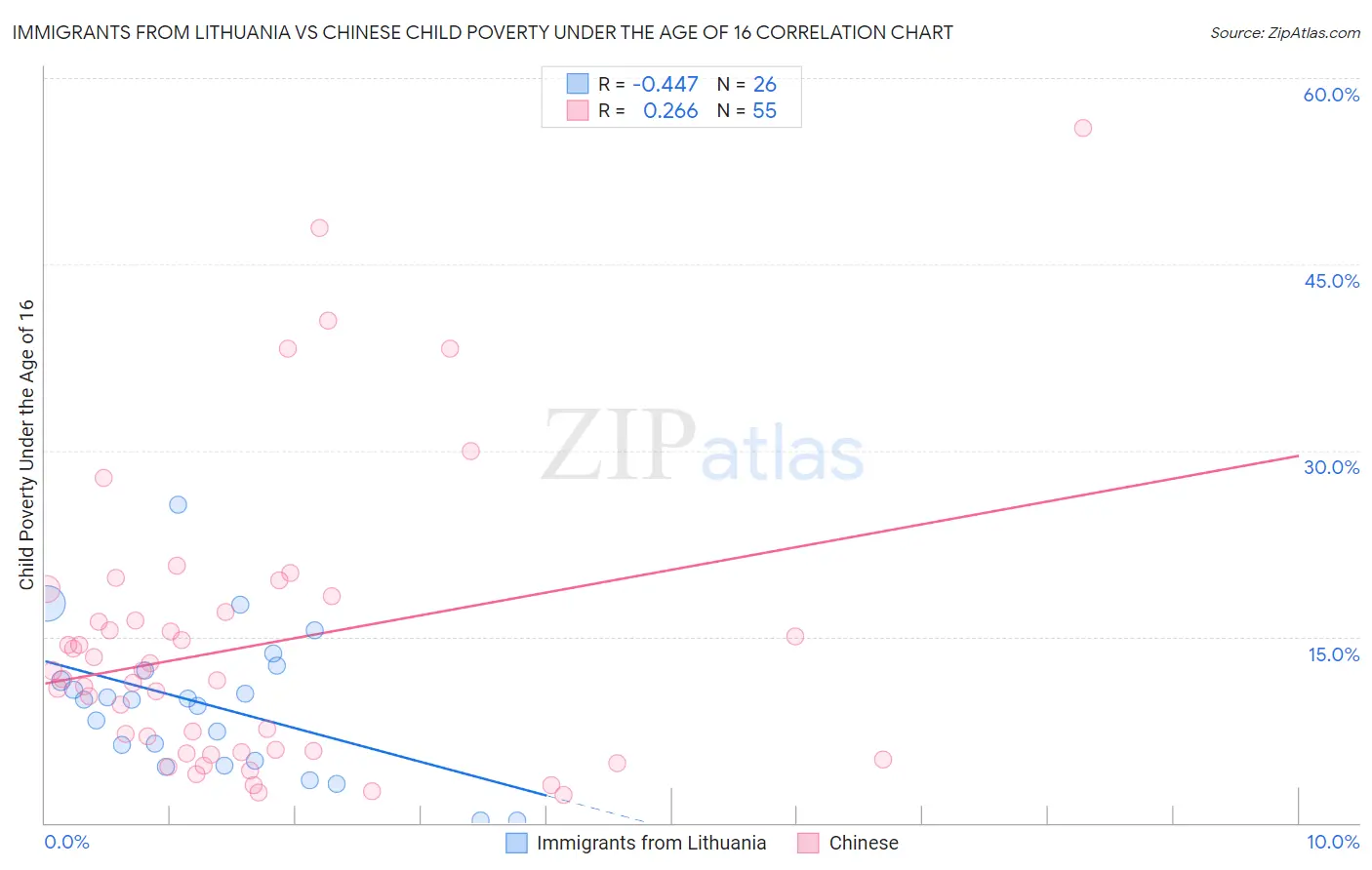Immigrants from Lithuania vs Chinese Child Poverty Under the Age of 16
COMPARE
Immigrants from Lithuania
Chinese
Child Poverty Under the Age of 16
Child Poverty Under the Age of 16 Comparison
Immigrants from Lithuania
Chinese
12.9%
CHILD POVERTY UNDER THE AGE OF 16
99.9/ 100
METRIC RATING
14th/ 347
METRIC RANK
11.9%
CHILD POVERTY UNDER THE AGE OF 16
100.0/ 100
METRIC RATING
5th/ 347
METRIC RANK
Immigrants from Lithuania vs Chinese Child Poverty Under the Age of 16 Correlation Chart
The statistical analysis conducted on geographies consisting of 117,283,790 people shows a moderate negative correlation between the proportion of Immigrants from Lithuania and poverty level among children under the age of 16 in the United States with a correlation coefficient (R) of -0.447 and weighted average of 12.9%. Similarly, the statistical analysis conducted on geographies consisting of 64,759,689 people shows a weak positive correlation between the proportion of Chinese and poverty level among children under the age of 16 in the United States with a correlation coefficient (R) of 0.266 and weighted average of 11.9%, a difference of 8.3%.

Child Poverty Under the Age of 16 Correlation Summary
| Measurement | Immigrants from Lithuania | Chinese |
| Minimum | 0.17% | 2.3% |
| Maximum | 25.6% | 56.0% |
| Range | 25.5% | 53.7% |
| Mean | 9.5% | 14.3% |
| Median | 9.9% | 11.6% |
| Interquartile 25% (IQ1) | 5.0% | 5.7% |
| Interquartile 75% (IQ3) | 12.2% | 17.0% |
| Interquartile Range (IQR) | 7.2% | 11.3% |
| Standard Deviation (Sample) | 5.7% | 11.6% |
| Standard Deviation (Population) | 5.6% | 11.5% |
Demographics Similar to Immigrants from Lithuania and Chinese by Child Poverty Under the Age of 16
In terms of child poverty under the age of 16, the demographic groups most similar to Immigrants from Lithuania are Immigrants from Korea (13.0%, a difference of 0.31%), Norwegian (13.0%, a difference of 0.35%), Bulgarian (13.0%, a difference of 0.58%), Burmese (12.8%, a difference of 0.84%), and Cypriot (13.0%, a difference of 1.0%). Similarly, the demographic groups most similar to Chinese are Immigrants from Hong Kong (12.1%, a difference of 1.8%), Iranian (12.2%, a difference of 2.6%), Thai (11.6%, a difference of 3.1%), Immigrants from Singapore (12.4%, a difference of 3.7%), and Immigrants from Iran (12.4%, a difference of 3.8%).
| Demographics | Rating | Rank | Child Poverty Under the Age of 16 |
| Immigrants | India | 100.0 /100 | #1 | Exceptional 10.8% |
| Immigrants | Taiwan | 100.0 /100 | #2 | Exceptional 11.0% |
| Filipinos | 100.0 /100 | #3 | Exceptional 11.1% |
| Thais | 100.0 /100 | #4 | Exceptional 11.6% |
| Chinese | 100.0 /100 | #5 | Exceptional 11.9% |
| Immigrants | Hong Kong | 100.0 /100 | #6 | Exceptional 12.1% |
| Iranians | 100.0 /100 | #7 | Exceptional 12.2% |
| Immigrants | Singapore | 100.0 /100 | #8 | Exceptional 12.4% |
| Immigrants | Iran | 100.0 /100 | #9 | Exceptional 12.4% |
| Immigrants | South Central Asia | 99.9 /100 | #10 | Exceptional 12.5% |
| Bhutanese | 99.9 /100 | #11 | Exceptional 12.5% |
| Immigrants | Ireland | 99.9 /100 | #12 | Exceptional 12.7% |
| Burmese | 99.9 /100 | #13 | Exceptional 12.8% |
| Immigrants | Lithuania | 99.9 /100 | #14 | Exceptional 12.9% |
| Immigrants | Korea | 99.9 /100 | #15 | Exceptional 13.0% |
| Norwegians | 99.9 /100 | #16 | Exceptional 13.0% |
| Bulgarians | 99.9 /100 | #17 | Exceptional 13.0% |
| Cypriots | 99.9 /100 | #18 | Exceptional 13.0% |
| Immigrants | Japan | 99.8 /100 | #19 | Exceptional 13.0% |
| Okinawans | 99.8 /100 | #20 | Exceptional 13.1% |